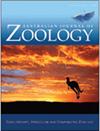Multiple trans-Torres Strait colonisations by tree frogs in the Litoria caerulea group, with the description of a new species from New Guinea
IF 1
4区 生物学
Q3 ZOOLOGY
引用次数: 2
Abstract
Abstract. Australia and New Guinea (together referred to as Sahul) were linked by land for much of the late Tertiary and share many biotic elements. However, New Guinea is dominated by rainforest, and northern Australia by savannah. Resolving patterns of biotic interchange between these two regions is critical to understanding the expansion and contraction of both habitat types. The green tree frog (Litoria caerulea) has a vast range across northern and eastern Australia and New Guinea. An assessment of mitochondrial and morphological diversity in this nominal taxon in New Guinea reveals two taxa. True Litoria caerulea occurs in disjunct savannahs of the Trans-Fly, Central Province and across northern Australia, with very low genetic divergence, implying late Pleistocene connectivity. A previously unrecognised taxon is endemic to New Guinea and widespread in lowland swampy rainforest. Date estimates for the divergence of the new species suggest Pliocene connectivity across lowland tropical habitats of northern Australia and New Guinea. In contrast, the new species shows shallow phylogeographic structuring across the central mountains of New Guinea, implying recent dispersal between the northern and southern lowlands. These results emphasise that the extent and connectivity of lowland rainforest and savannah environments across northern Australia and southern New Guinea have undergone profound shifts since the late Pliocene.树蛙群在托勒斯海峡的多个殖民地,描述了一个来自新几内亚的新物种
摘要在第三纪晚期的大部分时间里,澳大利亚和新几内亚(合称为Sahul)被陆地连接在一起,并共享许多生物元素。然而,新几内亚主要是热带雨林,而澳大利亚北部则是热带草原。解决这两个地区之间的生物交换模式对于理解这两种栖息地类型的扩张和收缩至关重要。绿树蛙(Litoria caerulea)在澳大利亚北部和东部以及新几内亚分布广泛。对新几内亚这个名义分类群的线粒体和形态多样性的评估揭示了两个分类群。真正的Litoria caerulea出现在跨蝇、中部省和整个澳大利亚北部的分离的稀树大草原上,遗传分化非常低,暗示晚更新世的联系。一种以前未被认识的分类群是新几内亚特有的,在低地沼泽雨林中广泛存在。对新物种分化的日期估计表明,上新世在澳大利亚北部和新几内亚的低地热带栖息地之间存在连通性。相比之下,新物种显示出横跨新几内亚中部山脉的浅层系统地理结构,这意味着它们最近在北部和南部低地之间分散。这些结果强调,自上新世晚期以来,澳大利亚北部和新几内亚南部的低地雨林和草原环境的范围和连通性发生了深刻的变化。
本文章由计算机程序翻译,如有差异,请以英文原文为准。
求助全文
约1分钟内获得全文
求助全文
来源期刊
CiteScore
2.40
自引率
0.00%
发文量
12
审稿时长
>12 weeks
期刊介绍:
Australian Journal of Zoology is an international journal publishing contributions on evolutionary, molecular and comparative zoology. The journal focuses on Australasian fauna but also includes high-quality research from any region that has broader practical or theoretical relevance or that demonstrates a conceptual advance to any aspect of zoology. Subject areas include, but are not limited to: anatomy, physiology, molecular biology, genetics, reproductive biology, developmental biology, parasitology, morphology, behaviour, ecology, zoogeography, systematics and evolution.
Australian Journal of Zoology is a valuable resource for professional zoologists, research scientists, resource managers, environmental consultants, students and amateurs interested in any aspect of the scientific study of animals.
Australian Journal of Zoology is published with the endorsement of the Commonwealth Scientific and Industrial Research Organisation (CSIRO) and the Australian Academy of Science.

 求助内容:
求助内容: 应助结果提醒方式:
应助结果提醒方式:


